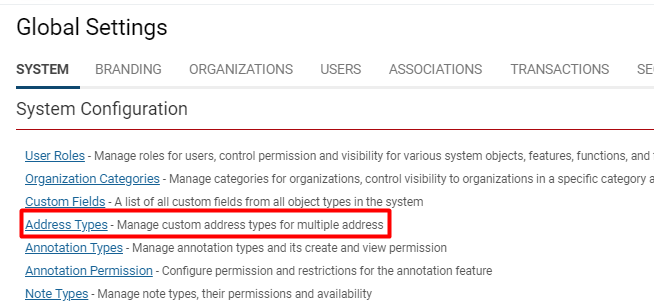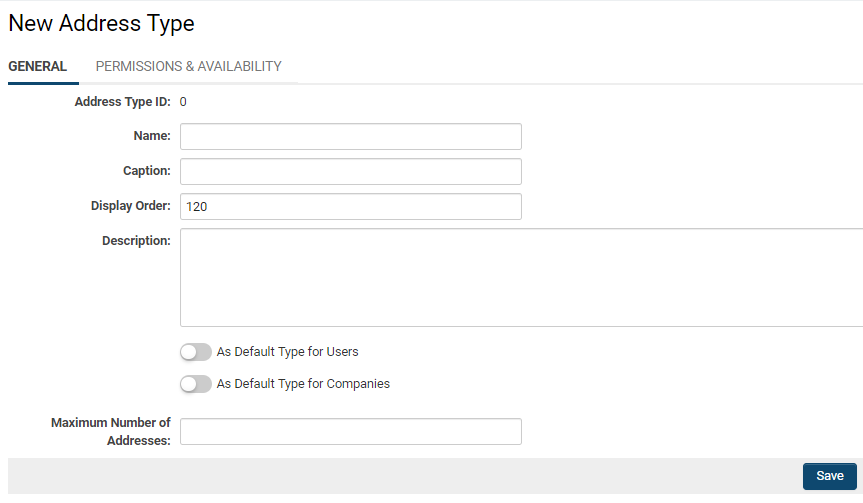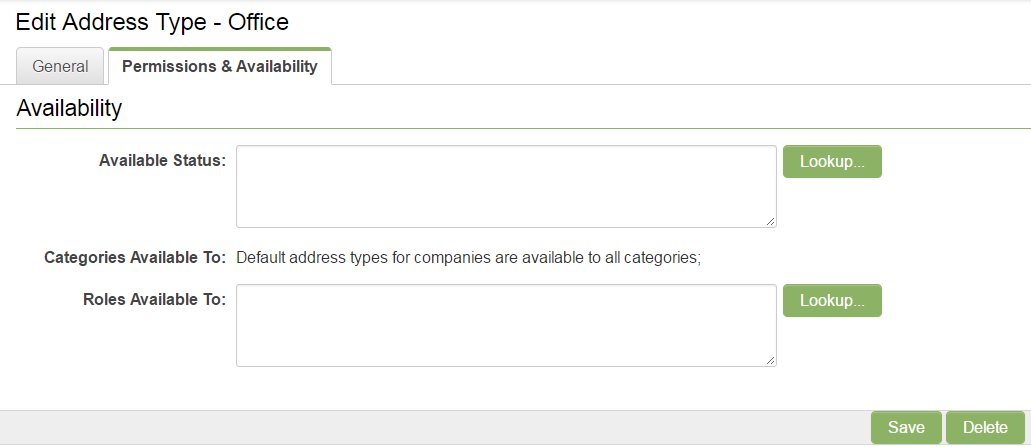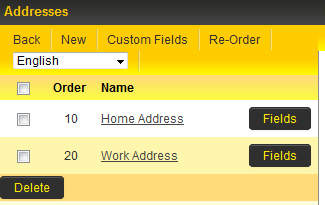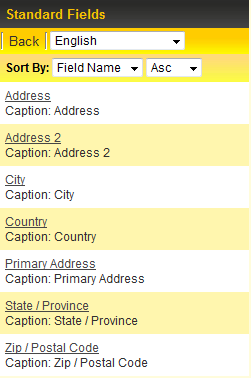Difference between revisions of "Address Types"
| Line 1: | Line 1: | ||
__TOC__ | __TOC__ | ||
| + | |||
==Overview== | ==Overview== | ||
| − | |||
The '''Address Types '''setting allows you to define a number of different address types to be used elsewhere in the system. | The '''Address Types '''setting allows you to define a number of different address types to be used elsewhere in the system. | ||
==Configuration - Essentials== | ==Configuration - Essentials== | ||
| + | ===Example of Address Type=== | ||
| + | '''Address Types '''are available to a [[User|user]] with a [[User role|role]] that an '''Address Type '''has been made available to. | ||
| + | |||
===Accessing Address Types=== | ===Accessing Address Types=== | ||
| − | |||
In order to use this feature, follow these steps: | In order to use this feature, follow these steps: | ||
| Line 15: | Line 17: | ||
:: {{Icon-Menu}} | :: {{Icon-Menu}} | ||
| − | |||
2. Under the heading '''Configuration, '''select '''Global Settings.''' | 2. Under the heading '''Configuration, '''select '''Global Settings.''' | ||
| Line 21: | Line 22: | ||
:: [[File:Address types.png|500px|border]] | :: [[File:Address types.png|500px|border]] | ||
| − | |||
The list of available Address Types will be displayed. If there are none in the system, this page will be blank. You can create and configure new Address Types by selecting the '''+ '''icon on the top left of your page. You can edit existing Address Types by selecting the '''pencil '''icon on the left of each Type name. | The list of available Address Types will be displayed. If there are none in the system, this page will be blank. You can create and configure new Address Types by selecting the '''+ '''icon on the top left of your page. You can edit existing Address Types by selecting the '''pencil '''icon on the left of each Type name. | ||
| − | ===Creating a New Address Type=== | + | ===Manually Creating a New Address Type=== |
| − | + | To create a new Address Type manually, after clicking the '''+ '''icon from the '''Address Types '''page, you must fill in the fields for the new type. | |
| − | To create a new Address Type, after clicking the '''+ '''icon you must fill in the fields for the new type. | ||
:: [[File:New address type.png|650px|border]] | :: [[File:New address type.png|650px|border]] | ||
| + | {| class="wikitable" | ||
| + | |- | ||
| + | ||'''Name''' | ||
| + | ||Text used to identify an address type | ||
| + | |- | ||
| + | ||'''Caption''' | ||
| + | ||Normally the same as '''Name, '''unless you want to add a label for the address type that is different | ||
| + | |- | ||
| + | ||'''Display Order''' | ||
| + | ||Address types will be displayed in the drop-down with regards to the [[Display order|display order]], with the lowest value of display order appearing first in the drop-down list. | ||
| + | |- | ||
| + | ||'''Description ''' | ||
| + | ||A general description for the address type | ||
| + | |- | ||
| + | ||'''Colour Code''' | ||
| + | ||An optional colour code for the address type when displayed | ||
| + | |- | ||
| + | ||'''Default Type''' | ||
| + | || | ||
| + | In order to use the '''Multiple Addresses '''feature, a default address must be selected. | ||
| + | * '''As Default Type for Users - '''Select this option to make this Address Type the default type for user records. | ||
| + | * '''As Default Type for Companies - '''Select this option to make this Address Type the default type for organization records. | ||
| + | |- | ||
| + | ||'''Maximum Number of Addresses''' | ||
| + | ||The maximum quantity of this specific type of address allowed. | ||
| + | |} | ||
| + | <br /> | ||
| Line 38: | Line 64: | ||
* '''IMPORTANT:''' when enabling you '''''must''''' follow the instructions on the [[Importing Address]] Wiki article to ensure the existing addresses are retained. If the ''Enable Multiple Address'' option is turned on without importing addresses from existing profiles or loading a new set of addresses, whenever a new address is added to a profile, the original data stored in the profile address will be lost. | * '''IMPORTANT:''' when enabling you '''''must''''' follow the instructions on the [[Importing Address]] Wiki article to ensure the existing addresses are retained. If the ''Enable Multiple Address'' option is turned on without importing addresses from existing profiles or loading a new set of addresses, whenever a new address is added to a profile, the original data stored in the profile address will be lost. | ||
| − | |||
| Line 45: | Line 70: | ||
* User can click on New to use the Import and Export options to copy across address types from other instances or can click on Addresses to manually enter new address type details. | * User can click on New to use the Import and Export options to copy across address types from other instances or can click on Addresses to manually enter new address type details. | ||
| − | |||
| − | |||
| − | |||
| − | |||
* The fields available include: | * The fields available include: | ||
| Line 59: | Line 80: | ||
*** '''As Default Type for Users''' - Select this option to make this Address Type the default type for user records. | *** '''As Default Type for Users''' - Select this option to make this Address Type the default type for user records. | ||
*** '''As Default Type for Companies''' - Select this option to make this Address Type the default type for company records. | *** '''As Default Type for Companies''' - Select this option to make this Address Type the default type for company records. | ||
| + | |||
<pre style="white-space: -o-pre-wrap; word-wrap: break-word;">Notes: If a Default Type is not set on an Address Type, the combo box for Address Types will not be displayed when adding/editing an address record. | <pre style="white-space: -o-pre-wrap; word-wrap: break-word;">Notes: If a Default Type is not set on an Address Type, the combo box for Address Types will not be displayed when adding/editing an address record. | ||
If an Address Type is made a "Default Type for Users," all roles will have access to this Address Type. | If an Address Type is made a "Default Type for Users," all roles will have access to this Address Type. | ||
If an Address Type is made a "Default Type for Companies," all categories will have access to this Address Type.</pre> | If an Address Type is made a "Default Type for Companies," all categories will have access to this Address Type.</pre> | ||
| + | ** | ||
**:* '''Maximum Number of Addresses''' - The maximum quantity of this type of address allowed. | **:* '''Maximum Number of Addresses''' - The maximum quantity of this type of address allowed. | ||
**:* '''Address Book Template''' - This setting can be used to personalize the block of text that is returned when using the @addressbook@ [[variable]]. See the [[Address Book Template]] page for configuration instructions. | **:* '''Address Book Template''' - This setting can be used to personalize the block of text that is returned when using the @addressbook@ [[variable]]. See the [[Address Book Template]] page for configuration instructions. | ||
| − | + | * | |
| − | + | * | |
[[image:New Multiple Address Permissions.PNG|link=]] | [[image:New Multiple Address Permissions.PNG|link=]] | ||
| + | ** | ||
**:* '''Roles Available to''' - User Roles that will be able to access and complete the specific address type from within their User Profile | **:* '''Roles Available to''' - User Roles that will be able to access and complete the specific address type from within their User Profile | ||
**:* '''Categories Available To''' - Organization Categories that will be able to access and complete the specific address type from within their Organization Profile | **:* '''Categories Available To''' - Organization Categories that will be able to access and complete the specific address type from within their Organization Profile | ||
| − | |||
*** Once the fields are populated as required then click Save. | *** Once the fields are populated as required then click Save. | ||
| + | |||
*** The Address Type will now be visible in the list of available address types. | *** The Address Type will now be visible in the list of available address types. | ||
| + | |||
[[image:Address_Types_Saved.png]] | [[image:Address_Types_Saved.png]] | ||
| Line 89: | Line 114: | ||
*** Click on the New Field tab at the top of the screen. | *** Click on the New Field tab at the top of the screen. | ||
| + | |||
[[image:AddessTypeNewField2.png]] | [[image:AddessTypeNewField2.png]] | ||
| Line 94: | Line 120: | ||
*** The '''New Custom Field''' window is displayed, with existing options for configuring required custom fields. See [[Custom Fields – General Information]] for further details. | *** The '''New Custom Field''' window is displayed, with existing options for configuring required custom fields. See [[Custom Fields – General Information]] for further details. | ||
| − | |||
| Line 105: | Line 130: | ||
*** Click on the Standard Fields tab at the top of the screen. | *** Click on the Standard Fields tab at the top of the screen. | ||
| + | |||
[[image:AddessTypeStandardNew.png]] | [[image:AddessTypeStandardNew.png]] | ||
| Line 110: | Line 136: | ||
*** User is presented with a list of available [[Contact and Account Standard Fields|Standard fields]]. | *** User is presented with a list of available [[Contact and Account Standard Fields|Standard fields]]. | ||
| + | |||
[[image:AddessTypeStandardOptions.png]] | [[image:AddessTypeStandardOptions.png]] | ||
| Line 116: | Line 143: | ||
*** Click on the hyperlink for a standard field and configure the visibility and validation that you wish to apply for that specific field. | *** Click on the hyperlink for a standard field and configure the visibility and validation that you wish to apply for that specific field. | ||
*** Click Save | *** Click Save | ||
| + | |||
==Referencing Address Types== | ==Referencing Address Types== | ||
*** The @primaryaddress@ and @addressbook@ variables can be used to reference addresses when multiple address types are enabled. See [[Address Book Template]] for more information. | *** The @primaryaddress@ and @addressbook@ variables can be used to reference addresses when multiple address types are enabled. See [[Address Book Template]] for more information. | ||
*** Individual Address Type values can be referenced using the [[Web_Page_View_Field_Variables#To_Display_a_List_of_Activities.2C_Notes.2C_Transactions.2C_Contacts.2C_Companies.2C_Consumers.2C_Providers|list syntax]] [#(?object=address) ... #] under a user or company. | *** Individual Address Type values can be referenced using the [[Web_Page_View_Field_Variables#To_Display_a_List_of_Activities.2C_Notes.2C_Transactions.2C_Contacts.2C_Companies.2C_Consumers.2C_Providers|list syntax]] [#(?object=address) ... #] under a user or company. | ||
| + | |||
==See Also== | ==See Also== | ||
*** [[Viewing Address Types]] | *** [[Viewing Address Types]] | ||
Revision as of 09:27, 17 June 2019
Contents
Overview
The Address Types setting allows you to define a number of different address types to be used elsewhere in the system.
Configuration - Essentials
Example of Address Type
Address Types are available to a user with a role that an Address Type has been made available to.
Accessing Address Types
In order to use this feature, follow these steps:
1. Click on the 9-square menu icon on the top right of your page.
2. Under the heading Configuration, select Global Settings.
3. Under the first tab, select Address Types.
The list of available Address Types will be displayed. If there are none in the system, this page will be blank. You can create and configure new Address Types by selecting the + icon on the top left of your page. You can edit existing Address Types by selecting the pencil icon on the left of each Type name.
Manually Creating a New Address Type
To create a new Address Type manually, after clicking the + icon from the Address Types page, you must fill in the fields for the new type.
| Name | Text used to identify an address type |
| Caption | Normally the same as Name, unless you want to add a label for the address type that is different |
| Display Order | Address types will be displayed in the drop-down with regards to the display order, with the lowest value of display order appearing first in the drop-down list. |
| Description | A general description for the address type |
| Colour Code | An optional colour code for the address type when displayed |
| Default Type |
In order to use the Multiple Addresses feature, a default address must be selected.
|
| Maximum Number of Addresses | The maximum quantity of this specific type of address allowed. |
In order to use this feature, you must first go to Global Settings > System and check off the "Enable Multiple Address" option.
- IMPORTANT: when enabling you must follow the instructions on the Importing Address Wiki article to ensure the existing addresses are retained. If the Enable Multiple Address option is turned on without importing addresses from existing profiles or loading a new set of addresses, whenever a new address is added to a profile, the original data stored in the profile address will be lost.
Creating New Address Type
- Click on Address Types link within the Business & System Configuration section of the Global Settings page.
- User can click on New to use the Import and Export options to copy across address types from other instances or can click on Addresses to manually enter new address type details.
- The fields available include:
- Name - text used to identify an address type
- Caption - used if you want to have a label for the address that is different than the name
- Display Order - address types will be displayed in the drop-down with regards to the "Display Order", with lowest value appearing first in the drop-down list.
- Description - a general description for the address type.
- Color Code- an optional color code for the address type when displayed.
- Default Type - In order to use the Multiple Address feature, a default address must be selected.
- As Default Type for Users - Select this option to make this Address Type the default type for user records.
- As Default Type for Companies - Select this option to make this Address Type the default type for company records.
Notes: If a Default Type is not set on an Address Type, the combo box for Address Types will not be displayed when adding/editing an address record. If an Address Type is made a "Default Type for Users," all roles will have access to this Address Type. If an Address Type is made a "Default Type for Companies," all categories will have access to this Address Type.
-
- Maximum Number of Addresses - The maximum quantity of this type of address allowed.
- Address Book Template - This setting can be used to personalize the block of text that is returned when using the @addressbook@ variable. See the Address Book Template page for configuration instructions.
-
-
- Roles Available to - User Roles that will be able to access and complete the specific address type from within their User Profile
- Categories Available To - Organization Categories that will be able to access and complete the specific address type from within their Organization Profile
-
- Once the fields are populated as required then click Save.
- The Address Type will now be visible in the list of available address types.
Add Custom Fields to Address Type
- Click on the Fields button to the right of the Address Type name you wish to add custom fields against.
- Click on the New Field tab at the top of the screen.
- The New Custom Field window is displayed, with existing options for configuring required custom fields. See Custom Fields – General Information for further details.
Add Standard Fields to Address Type
- Click on the name of the Address Type as displayed in the Name column.
- Click on the Standard Fields tab at the top of the screen.
- User is presented with a list of available Standard fields.
- Click on the hyperlink for a standard field and configure the visibility and validation that you wish to apply for that specific field.
- Click Save
Referencing Address Types
- The @primaryaddress@ and @addressbook@ variables can be used to reference addresses when multiple address types are enabled. See Address Book Template for more information.
- Individual Address Type values can be referenced using the list syntax [#(?object=address) ... #] under a user or company.
